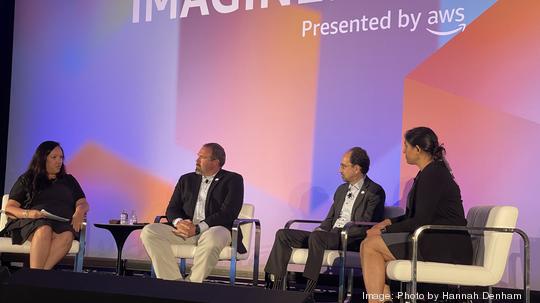
The first cohort of students to enroll in Northern Virginia Community College's associate cloud computing degree, launched with Amazon Web Services in 2018, were predominantly students of color.
Chad Knights, NOVA’s vice president of IET and college computing, said Monday during AWS' “IMAGINE: Education” conference that between 65% and 70% of the program’s first class of students, now in their final year, are diverse, at least in terms of race and ethnicity.
But NOVA has struggled to attract women to its cloud computing degree program, Knights said. The community college recently launched a speaker series for women in IT as one step to boost female participation in, and attention to, the program.
“Where we fell down was on the gender field. The gender field was really disproportionate,” Knights said on a panel about Amazon's cloud computing arm’s partnerships with degree programs at NOVA and George Mason University. “We are still focused keenly on both and trying to identify barriers that exist that we can overcome to support both populations.”
AWS partnered with Mason in 2019 to create a cloud computing program as well as a four-year bachelor’s of applied science degree.
Part of what drew Amazon.com Inc. (NASDAQ: AMZN) to Northern Virginia as the location of its second headquarters, announced in November 2018, was its promised investments in tech education to meet growing workforce demands. Since then, university and community college programs in cloud computing, computer engineering and other data analytics-related fields, like those at NOVA and Mason, have grown with state funding and corporate partnerships to form an evolving "innovation corridor."
But the influx still isn't enough to keep up with the expected 25,000 jobs that Amazon has promised Virginia it will fill at HQ2 by 2030 in exchange for $550 million in cash incentives. And that's just a minimum: Amazon could hire a total of 37,850 people by 2035, if the company wants another $220 million in state funds.
With that growth, and the growth of countless other tech firms and federal contractors in the area, the pressure is on to create a pipeline of tech talent to fill those jobs, pulling from a diverse, local pool of prospective students and job candidates.
One of the major barriers to entry for women and people of color in the tech field is the cost to enroll in its information technology programs, Knights said, adding that NOVA was digging more into enrollment and demographic data to understand where students and prospective tech workers would need more support.
Recruiting diverse students for the college’s data center operations degree program has been especially difficult, so he’s reached out to industry leaders in Northern Virginia to figure out how the college can improve, Knights said. Northern Virginia is the world's data center hub, and Amazon is among its leaders.
For NOVA and Mason, churning out local tech talent starts in high school, with dual enrollment courses and recruitment. Kamaljeet Sanghera, Mason’s interim executive director for the Institute for Digital Innovation, which launched a little more than a year ago and will set up shop at the school's expanding Arlington campus, said the university specifically recruits in local high schools for female students interested in the field of engineering.
“That is about increasing the pipeline, and of course retaining is very important to us,” Sanghera said.
Mason’s large population of first-generation and Pell Grant students, in addition to students of color, places the university in an easier position to directly contribute to a more diverse talent pipeline, said Marc Austin, the school's executive director of professional education and academic ventures.
“That’s step one: look for programs that are already attracting students that have that makeup and diversity that we’re looking for,” Austin said. The next step, he said, is to advertise to that diverse population when pitching programs to prospective students.
Amazon said at the beginning of September it has filled more than 3,000 corporate jobs for HQ2, and job listings as of Monday show more than 2,800 local openings, many of which are software development engineer roles for AWS.